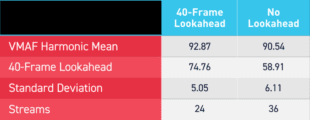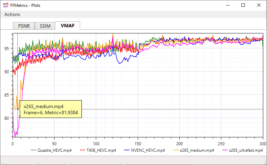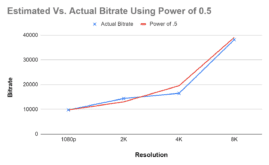This article is the second in a series about benchmarking hardware encoding performance. In the first article, available here, I delineated a procedure for testing hardware encoders. Specifically, I recommended this three-step procedure: Identify the most critical quality and throughput-related options for the encoder. Test across a range of configurations from high quality/low throughput to low quality/high throughput to identify …
Read More »Search Results for: x265
How to Compare Hardware Transcoders
This article details a methodology for comparing hardware transcoders considering cost/stream, watt/stream, and output quality. If you’ve ever benchmarked software codecs, you know the quality/throughput tradeoff; simply stated, the higher the quality, the lower the throughput. In contrast, for many first-generation hardware encoders, throughput was prioritized, but the quality was fixed; you got what you got. Finding the Key Quality …
Read More »Dense is good when it comes to transcoding
Back in high school, if someone called you dense, it meant you were slow on the uptake, and it definitely wasn’t a compliment. For high-volume video transcoding, however, density is, without question, a major plus. Some background. I now work with NETINT, a Canadian company that designs, develops, and sells ASIC-powered transcoders like the T408 and T432, which can output H.264 and …
Read More »Installing and Using FFMetrics to Compute and Visualize VMAF, SSIM, and MS SSIM Metrics
This tutorial teaches you how to install and use FFMetrics, a free tool that lets you compute and visualize VMAF, SSIM, and PSNR on up to 12 files. Let me start this article by stating that the one program I couldn’t live without in my role as video tester and evaluator is the Moscow State University Video Quality Measurement Too …
Read More »SVT-AV1 and Libaom Tune for PSNR by Default
As of June 22, 2022, libaom-AV1 and SVT-AV1 tune for PSNR by default, and libaom-AV1 doesn’t appear to have a mode that optimizes actual video quality. Be sure to verify and consider this when comparing the codecs to others. Most of the time with codec experimentation, a lapse in attention costs you hours, days, or weeks of re-encoding and re-testing, …
Read More »Encoding for Transcoding vs Encoding for Distribution
A consulting client sent the following command string for a 1080p file they were encoding for upload to Vimeo, their online video platform. crf=20:vbv-maxrate=10000:vbv-bufsize=9500 What’s wrong with these parameters? First, some theory. One distinction to understand when encoding files is the difference between producing a mezzanine file to use for subsequent transcoding and encoding for distribution. When producing a mezzanine …
Read More »Estimating the Bitrate for 8K Videos When Encoding with HEVC and AV1
It’s a well-known and oft-repeated truism that codecs operate more efficiently at higher resolutions. The question is, is the truism really true? It turns out that it is, and we prove it below. To lend numbers to our truism and focus the issue, the basic question is this. 8K video has 16 times the pixels of 1080p videos. So, if …
Read More »VVC Performance, Royalty, and Implementation Status
VVC reached First Draft International Specification in July 2020. We’re about 18 months past that date and it’s useful to check in on VVC progress to date, including licensing, performance, chipset development, and trials. VVC Patent Owners Video quality is nice, but money makes the world go-’round, so let’s start here. Understand that video compression standards like VVC will have …
Read More »Does FFmpeg 5 Break Your Scripts?
FFmpeg turns 5.0; the new release has big API changes but doesn’t appear to break existing command scripts, though x265-based encodes are worth checking. As much as we like major releases of programs that we know and love, one big question is always whether it changes how we use the program. If you haven’t heard, on January 17, 2022, FFmpeg …
Read More »Testing EVC, VVC, and LCEVC
This article compares VVC, EVC, and LCEVC with H.264, HEVC, and AV1. Its’ useful if you’re attempting to understand the goals and capabilities of these codecs. In 2020, MPEG announced three new codecs, Versatile Video Coding (VVC), Essential Video Coding (EVC), and Low Complexity Enhancement Video Coding (LCEVC). As of January 2022, all are released and available for testing which I …
Read More » Streaming Learning Center Where Streaming Professionals Learn to Excel
Streaming Learning Center Where Streaming Professionals Learn to Excel











